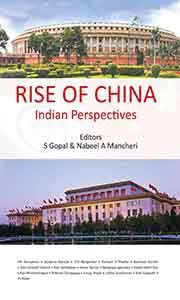To understand Chinese perceptions about India, one needs to access a variety of sources — one, statements by Party and Government leaders/spokes-persons; two, Party and state official documents; three, official media; four, PLA and five, netizens. Out of these sources the first two, for obvious reasons, can be said to reflect official viewpoint. Regarding official media, their editorials touching upon India, by and large, enjoy the blessings of the authorities and as such can be seen authoritative. The media also project the viewpoints of individual writers and their management takes care in informing the readers that it is not responsible for what such writers say. Even then, such opinions remain important in discerning policy trends in China. The netizens, coming under the last category, have grown in number in recent years and their opinions are independent. Even then, signs of state sponsorship of twitters etc. are there to see.
A broad conclusion is that information still remains under Party-State control. A key point is that Chinese official opinions on India are generally cautious, with stress on an achieved ‘win-win’ situation in bilateral relations. The official media on the other hand do not hesitate to make harsh criticisms against India particularly on strategic issues dividing the two nations. On their part China’s military writers seem to be under the influence of nationalism, giving rise to belief that the PLA shapes the country’s foreign policy.
There is an attempt to give a meaning to the stand points on India of various sources as mentioned above on the basis of some case studies and arrive at an integrated picture. In any case, what becomes clear is that China is deliberately adopting a two-pronged strategy towards India — diplomatically benign but territorially assertive.
China’s perceptions of India have remained and continue to be a key factor in the matter of understanding Beijing’s overall policy approach towards New Delhi at any given time; it goes without saying that a correct appraisal would provide a solid ground to the analysts of the subject, more importantly to the authorities in India responsible for making China policy. Conversely, it is true that a sound evaluation of Indian perceptions of China would be of help to Beijing in formulating its India policy. At a time when an atmosphere of trust deficit, contributed mainly by the existing divisions on strategic issues, is affecting their ties, it becomes necessary for the two simultaneously rising Asian giants, to narrow down the prevailing perceptional gaps between them and work together in creating regional stability and prosperity amidst expectations that the 21st century will be an Asian century. Wishes apart, it cannot be denied at the same time that for India and China, realisation of this task is not going to be easy.
A discussion on Chinese perceptions of India should start with a look at Beijing’s traditional view. China considers India as ‘Western Heaven’ while seeing itself as ‘Eastern Heaven’ and placing other parts of the world ‘under the heaven’. Such a vision of India-China ‘partnership’ in heaven looks no doubt symbolic of Chinese traditional goodwill towards India. How this compares with the current China-India ‘strategic and cooperative partnership for peace and prosperity’, is worth examining.
A second traditional aspect relating to China’s perceptions of outside world including India is rooted in its tendency to ‘judge all other states at various levels of tributaries, on the basis of approximation to Chinese cultural and political forms’, as Dr Kissinger puts it in his book On China. A valid question is whether such traditional ‘tributary’ mindset influences China’s approach toward India in the modern era.
A third Chinese traditional view which may be relevant to India pertains to territories. The Chinese have no sense of ‘territories’, perceiving all of them as belonging to the Emperor, called ‘son of Heaven’. One needs to correlate this with the Chinese border claims against India. Behind China’s ‘territorial ambition’, may lie the same view. In its Historical Atlas series, published in late eighties by the Cartography Publishing House, Beijing, lamented on ‘historical’ loss of territories for China, which included parts of India’s Northeast region and even Andamans. Mao had termed Tibet as the palm of China’s hand and its five fingers as Ladakh, Sikkim, Nepal, Bhutan and NEFA.
In contemporary sense, Chinese perceptions of India can be gathered from a variety of sources — statements of leaders and officials as well as official documents, official media, think tanks, military personnel, netizens and common man. Taking the first category at the outset, some recent statements of top leaders convey the general trend — utmost importance being given by China to ties with India, in spite of differences. President Hu Jintao at the BRICS Summit (Sanya, April 13 , 2011) has focused on the ‘global and strategic significance of Sino-Indian relations’. Premier Wen Jiabao has remarked (Bali, November 18, 2011) that ‘peace and common development are in the common interests of China and India’. Secondly, no leader or official document in China has so far mentioned about ‘Southern Tibet’, they only referred to the ‘border issue’. Thirdly, Chinese officials have stated that Beijing will take care of India’s ‘core interests’ and so should New Delhi. Fourthly, on India’s agreement with Vietnam for oil exploration in South China Sea, the response from the Chinese foreign ministry spokesperson has been measured. Lastly, the statement made by the Chinese Ambassador in New Delhi prior to Premier Wen Jiabao’s visit to India that China-India ties are ‘fragile’ and need ‘special care’, has indicated the Chinese cautious attitude towards issues dividing India and China.
Coming to the Chinese official media, what the party journal Liaowang (Outlook’) stated appears important. It observed that India’s place in the international system cannot be ignored given its economic, demographic and historical strength as well as the increase in its global status in the post-financial crisis period. The party-affiliated Huan Qiu, the Chinese language version of the Global Times, carries a regular column on India, a treatment given on par with the cases of the US, Russia, South Korea and Japan.
At the same time, the party and state-controlled media have not hesitated to vehemently criticise India, deviating from cautious official positions. Prominent themes taken up by them in this regard included India’s dispatch of additional troops to the Northeast, New Delhi-Hanoi oil exploration in South China Sea, border issue, the Dalai Lama activities, India-US strategic ties and India’s missile programme. What follows is a sampling in this regard.
On Indian additional troops, the Chinese language edition of the party-run Global Times, (Huan Qiu) (October 21, 2011) described India’s ‘military buildup in the border’ as a ‘threat’ to China. People’s Daily (November 10, 2011) called Indian troops deployment in the Northeast as ‘second phase of border build-up’ and commented that India has begun to treat China as an opponent. The same daily had earlier warned (November 29, 2009) about the consequences for India of a potential conflict with China and attacked India of having a desire to start an immediate war with China. Ya Dong Junshi website (Chinese) alleged (October 16, 2010) that India is turning its attention to ‘Southern Tibet’ taking advantage of China’s pre-occupation with South China Sea.
On India’s role in South China Sea, the Global Times comments are worth noting. It said (October 14, 2011) that India has deeper strategic considerations, its role amounted to ‘serious political provocation’ to China and that India wants to use it as a ‘bargaining chip’ on issues with China. The journal went further and observed (November 30, 2011) that India is becoming ‘increasingly bold and assertive with interest to develop a face-off with China and China should take this trend seriously.’ Xinhua (November 25, 2011) found an ‘inferiority complex’ on India’s part and its subsequent commentary found India being ambitious and acting in immaturity while cautioning India against ‘crossing the insurmountable red line.’
On the border issue, the Chinese official media are adopting positions, further elabourating the official stand. While at official levels, China is desiring to reach a fair, reasonable, solution acceptable to both the sides on the basis of peace, friendliness, equal consultations, mutual respect and understanding, Huan Qiu (October 21, 2011) criticised India for its stubbornness on recognition of the status quo on the boundary problem, deviating from the spirit of the mutually agreed political parameters principle. A scholar representing an official think-tank Prof Wang Hungwei wanted India to make practical concessions to China in the Eastern sector.
On the Dalai Lama issue, Huan Qiu (November 9, 2009) directly accused India of ‘coveting the Dalai Lama’ and the China-Tibet Online edition quoted a scholar as warning India that if it does not abandon its ‘political manipulation of the Dalai Lama’, the Chinese government will give a blow to India.
On India-US strategic ties, the party theoretical organ Qiu Shi (September 14, 2009) stated that the US-India military cooperation will change the strategic situation in South Asia.
On India’s missile development programme, the People’s Daily (December 19, 2011) characterised India’s ‘Agni’ missile tests as reflecting its ‘regional strategic ambitions.’
The Chinese official media criticisms against India’s stand on China-Pakistan ties are also notable. The China Youth Daily (Chinese, November 27, 2009) through an article written by Hao Ding, a scholar of the Chinese Academy of Military Sciences, alleged that India’s new defence strategy treats China, not Pakistan, as a military target. A Chinese scholar, Prof Zhao Gancheng of the Shangahi Institute of International Studies revealed (May 10, 2010) that China is reassessing its South Asia policy in response to India’s practicing hegemony in that region without paying attention to the strategic autonomy interests of other South Asian nations.
What the Chinese netizens say on India, mostly in Chinese language, are also to be considered in assessing the Chinese perceptions of India. On many occasions, they have been abusive and aggressive, for example, they talked about a partial war with India on the border issue and a blog even advocated for ‘spitting India’ into independent parts. As far as common man in China is concerned, they mostly look toward the West as a model, paying little attention to India. This is not to deny the recognition among Chinese entrepreneurs to India as a software giant.
In a nutshell, what can be seen is that China is speaking in two voices in its assessment of India. Official perceptions are generally warm and restrained, in diplomatic interests. But what the party and state-controlled media, scholars of strategic think-tanks and some retired military officers say on India cannot be ignored; they also represent China’s voice. In China, party is supreme and its views, often expressed through its media, should be considered as prevailing over others.
Since mid-2008, China is showing a great degree of assertiveness in international relations, especially on ties with neighbours including India; its assertiveness is basically on sovereignty-related issues, on the basis of perceived core-interests. New Delhi should develop a composite view of Chinese perceptions — both official and non-official, as it engages China. Its priority should be on the question — what China thinks about India strategically.





